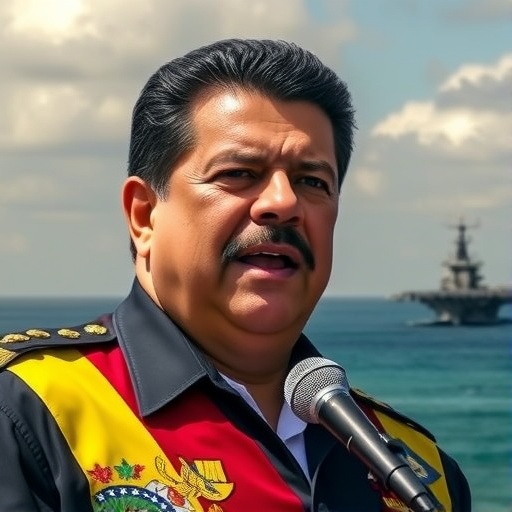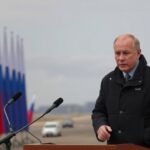Venezuela‘s Maduro Blasts US for ‘Fabricated War’ as World’s Largest Aircraft Carrier Approaches Caribbean Waters
In a blistering address to the nation, Venezuelan President Nicolas Maduro has accused the United States of manufacturing a pretext for war, just as the US military’s colossal aircraft carrier, the USS Gerald R. Ford, steams toward the Caribbean amid heightened tensions. This dramatic escalation under the Trump administration underscores a deepening rift in Venezuela-US relations, with Maduro vowing to defend his sovereignty against what he calls imperial aggression.
- Maduro’s Rallying Cry: Imperialism’s Latest Assault on Venezuelan Sovereignty
- USS Gerald R. Ford’s Shadow: Decoding the US Military’s Strategic Maneuver
- Trump’s Venezuela Obsession: From Tweets to Troop Movements
- Global Echoes: Allies Rally as Tensions Grip Latin America
- Path to De-Escalation? Diplomatic Maneuvers Amid Military Posturing
The USS Gerald R. Ford, the world’s largest warship with a displacement of over 100,000 tons and capable of carrying up to 75 aircraft, was deployed from its home port in Norfolk, Virginia, last week. Official US statements describe the movement as a routine exercise to support regional security, but Venezuelan officials interpret it as a direct threat. “They are forging a war against us, but we will not bow to their threats,” Maduro declared during a televised speech from Caracas, flanked by military leaders.
Maduro’s Rallying Cry: Imperialism’s Latest Assault on Venezuelan Sovereignty
President Nicolas Maduro‘s accusations came during a fiery rally in the heart of Caracas, where thousands of supporters gathered under a sea of red banners. Drawing parallels to historical US interventions in Latin America, Maduro painted the approaching US military presence as the latest chapter in a long saga of Yankee imperialism. “The empire is at our doorstep with their floating fortress, but Venezuela stands united,” he proclaimed, his voice echoing through the Plaza Bolívar.
This isn’t the first time Maduro has invoked such rhetoric. Since assuming power in 2013 following the death of Hugo Chávez, he has frequently clashed with Washington over Venezuela‘s socialist policies and human rights record. However, the timing of this latest outburst coincides with the Trump administration’s renewed focus on the region. In 2017, Trump infamously suggested a “military option” for Venezuela, a statement that sent shockwaves through Latin American diplomacy. Now, with the aircraft carrier deployment, those words seem to carry renewed weight.
Experts note that Maduro‘s speech was carefully orchestrated to bolster domestic support amid Venezuela‘s ongoing economic crisis. Hyperinflation has ravaged the economy, with the bolívar losing over 99% of its value since 2013, according to International Monetary Fund data. Unemployment hovers around 30%, and food shortages remain a daily reality for millions. By framing the US as the villain, Maduro shifts blame from internal mismanagement to external sabotage—a tactic straight out of the Chávez playbook.
During the rally, Maduro quoted Simón Bolívar, Venezuela’s liberator, emphasizing national resilience: “We have defeated empires before, and we will do so again.” He also called for nationwide military drills, ordering the activation of Venezuela‘s National Bolivarian Armed Forces to prepare for potential incursions. Satellite imagery released by Venezuelan state media shows increased activity at key airbases near the coast, including the deployment of Russian-supplied S-300 air defense systems.
USS Gerald R. Ford’s Shadow: Decoding the US Military’s Strategic Maneuver
The aircraft carrier in question, USS Gerald R. Ford (CVN-78), represents the pinnacle of US military might. Commissioned in 2017 at a cost of $13 billion, it features advanced electromagnetic catapults for launching fighter jets and can sustain operations for 90 days without resupply. Accompanied by a carrier strike group including destroyers, cruisers, and submarines, the Ford’s approach to the Caribbean—estimated to be within 500 miles of Venezuelan shores by week’s end—has sparked alarm in Venezuela.
US officials, speaking on condition of anonymity, insist the deployment is part of Joint Interagency Task Force South operations, aimed at countering drug trafficking and humanitarian concerns in the region. “Our presence ensures stability and supports allies like Colombia,” a Pentagon spokesperson told reporters. Yet, the optics are undeniable: the aircraft carrier‘s path traces a route that could position it to monitor or interdict Venezuelan oil shipments, a lifeline for Maduro‘s regime.
Venezuela relies on oil exports for 95% of its revenue, per OPEC statistics, but US sanctions imposed under Trump have crippled this sector. In 2019 alone, sanctions led to a 40% drop in oil production, exacerbating the humanitarian crisis. The US military has previously conducted freedom of navigation exercises in disputed waters, and analysts speculate this deployment could test Venezuela‘s response to such actions.
Military experts, including retired Admiral James Stavridis, have weighed in on the implications. In a recent op-ed for Foreign Policy, Stavridis described the Ford’s capabilities: “With F-35 stealth fighters and E-2 Hawkeye surveillance planes, it projects power across thousands of square miles.” He cautioned that while confrontation is unlikely, the move signals Trump‘s unwillingness to tolerate Maduro‘s alliances with Russia and China, who have provided Venezuela with loans and military hardware in defiance of US pressure.
Trump’s Venezuela Obsession: From Tweets to Troop Movements
Under President Donald Trump, Venezuela has become a focal point of foreign policy, blending ideological opposition to socialism with strategic concerns over energy security. Trump‘s administration has layered sanctions on Maduro‘s inner circle, designating over 150 Venezuelan officials as corrupt or human rights abusers. In January 2019, Trump recognized opposition leader Juan Guaidó as interim president, a move that isolated Maduro internationally but failed to oust him.
Recent White House statements reflect this hardline approach. National Security Advisor Robert O’Brien remarked, “The US military is postured to protect American interests, and Venezuela‘s instability threatens the hemisphere.” Trump himself took to Twitter—now X—last month, posting: “Maduro is a disaster for Venezuela. Time for change!” This digital drumbeat has paralleled on-the-ground actions, including the aircraft carrier deployment.
Historically, US-Venezuela ties have fluctuated. In the early 2000s, under Chávez, relations soured over oil prices and anti-US rhetoric. By 2019, Trump‘s “maximum pressure” campaign included asset freezes and travel bans. A 2020 report by the Center for Strategic and International Studies highlighted how these measures reduced Venezuela‘s GDP by 65% since 2013, fueling migration waves that have seen over 5.4 million Venezuelans flee to neighboring countries.
Critics within the US, including some Democrats, argue that Trump‘s tactics risk broader conflict. Senator Bernie Sanders tweeted: “Escalating military presence in Latin America echoes past mistakes. Diplomacy, not carriers, is the answer.” Meanwhile, Maduro has leveraged the tension to court support from allies like Iran, which recently shipped fuel to Venezuela despite US naval patrols in the region.
Global Echoes: Allies Rally as Tensions Grip Latin America
The brewing standoff has reverberated across the globe, with Venezuela‘s allies issuing statements of solidarity. Russian President Vladimir Putin, whose country has invested $17 billion in Venezuela since 2006, condemned the US military move as “provocative.” Moscow has stationed troops in Venezuela for joint exercises and supplied Sukhoi fighter jets, complicating any potential US action.
China, Venezuela‘s largest creditor with $60 billion in loans, urged restraint through state media. “Unilateral military deployments undermine regional peace,” a Xinhua commentary stated. In Latin America, reactions are mixed: Colombia, a US partner, has bolstered its border security, while Brazil under President Jair Bolsonaro has echoed Trump‘s calls for Maduro‘s removal.
The United Nations has called for de-escalation, with Secretary-General António Guterres expressing concern over the humanitarian toll. Over 7 million Venezuelans require aid, according to UN estimates, and any conflict could trigger a refugee surge rivaling Syria’s. Economic analysts predict oil prices could spike 10-15% if tensions boil over, impacting global markets.
Regional bodies like the Organization of American States (OAS) are convening emergency sessions. OAS Secretary-General Luis Almagro, a vocal Maduro critic, stated: “This is a moment of truth for democracy in the Americas.” Meanwhile, European nations, which recognized Guaidó in 2019, are monitoring the aircraft carrier‘s position via public tracking sites like MarineTraffic.
Path to De-Escalation? Diplomatic Maneuvers Amid Military Posturing
As the USS Gerald R. Ford cuts through Atlantic waves, backchannel talks could hold the key to averting crisis. US envoys have reportedly engaged Norway, which mediated Venezuela opposition dialogues in 2019, to explore confidence-building measures. Maduro, for his part, has signaled openness to dialogue but insists on lifting sanctions first.
Looking ahead, analysts foresee several scenarios. A low-probability hot conflict could involve cyber disruptions or limited naval skirmishes, but most expect posturing to yield negotiated outcomes. The Trump administration’s midterm elections loom, potentially influencing a softer approach. For Venezuela, sustaining alliances with Russia and China remains crucial, while domestic reforms could ease pressures.
International observers, including the Carter Center, advocate for electoral transparency to resolve the political impasse. As Maduro prepares for 2024 elections, the US military‘s shadow may force his hand. In the words of Maduro himself: “Peace is our weapon, but we are ready for defense.” The world watches, hoping rhetoric gives way to resolution before the aircraft carrier‘s props stir more than waves.










